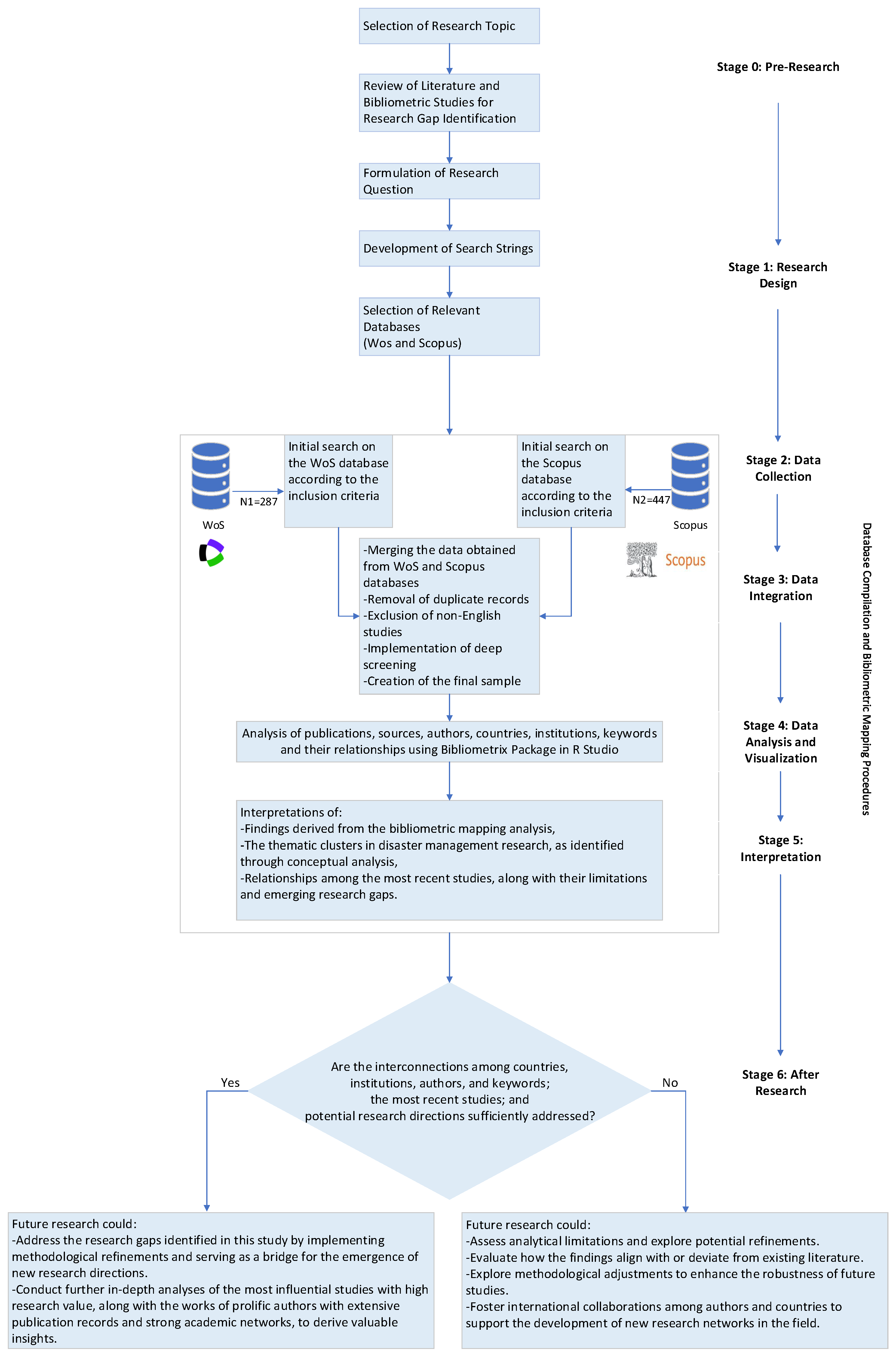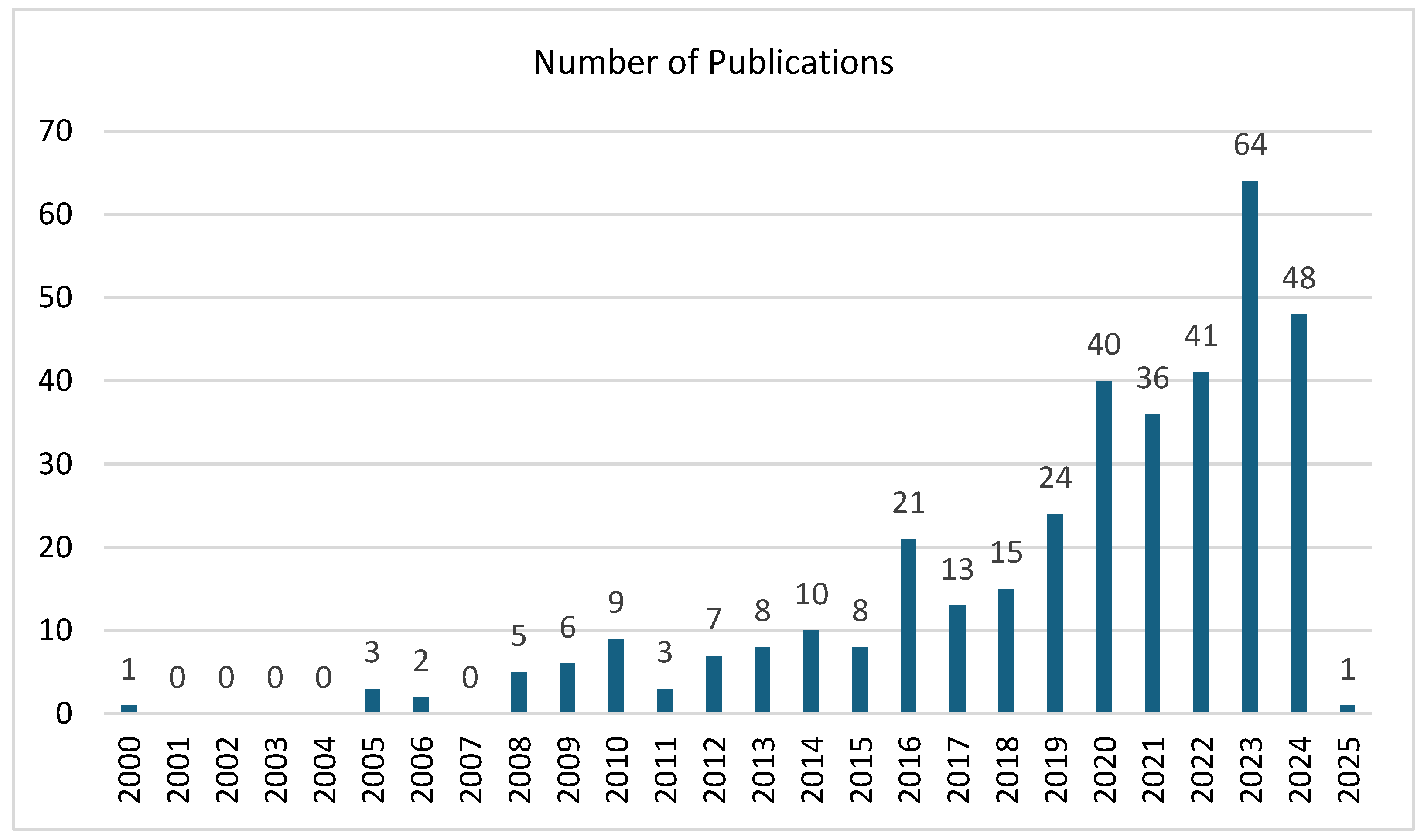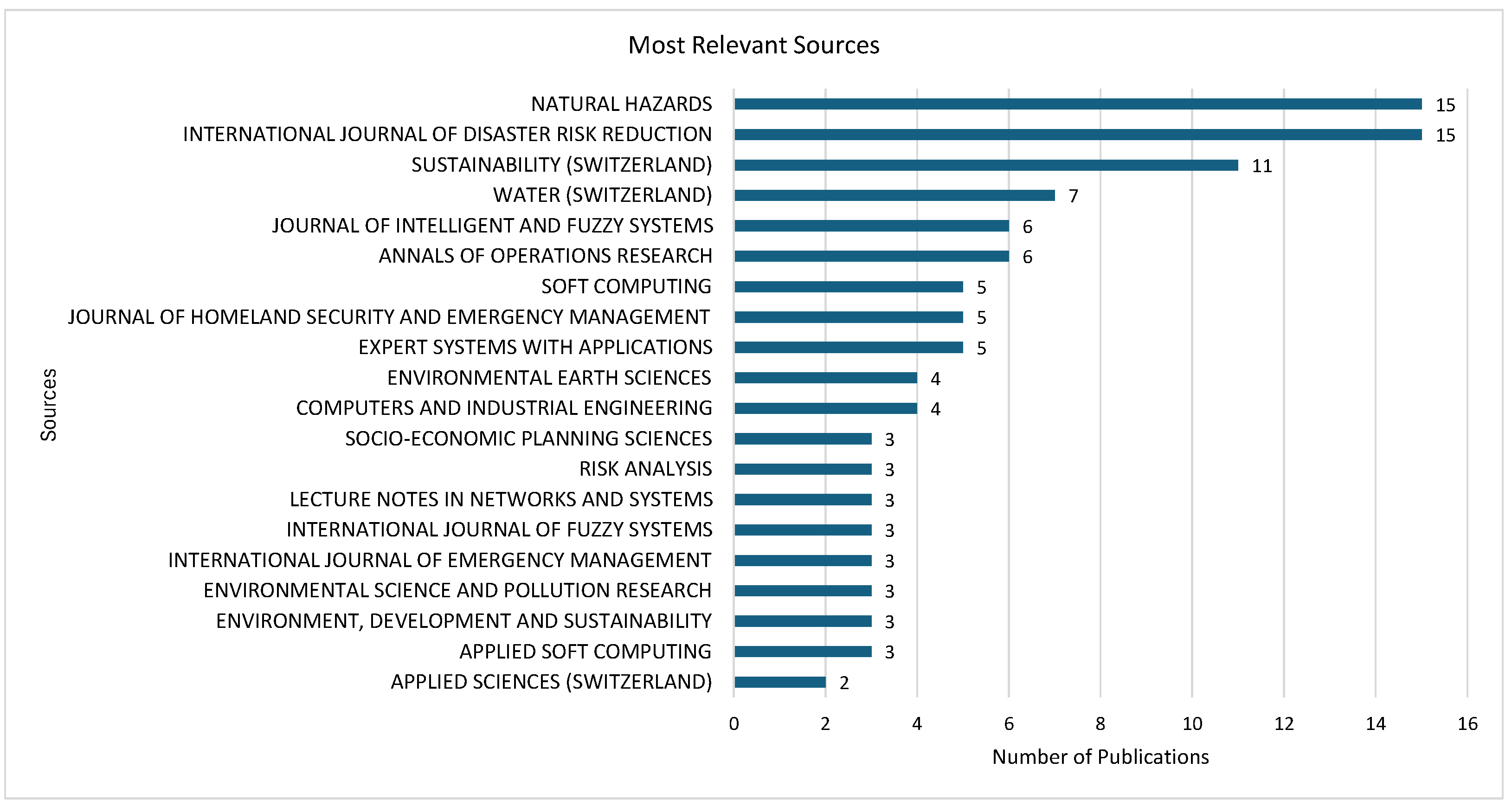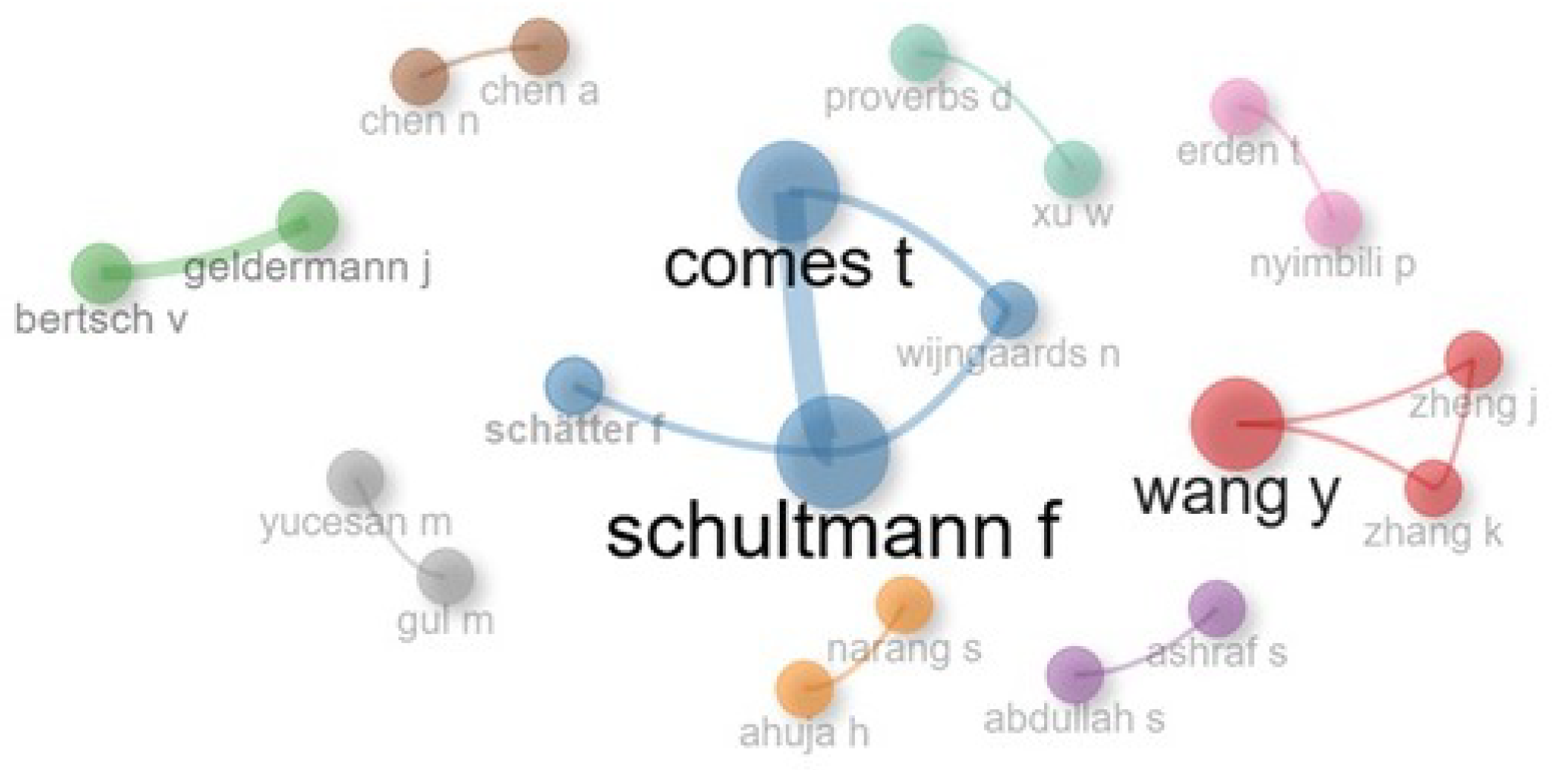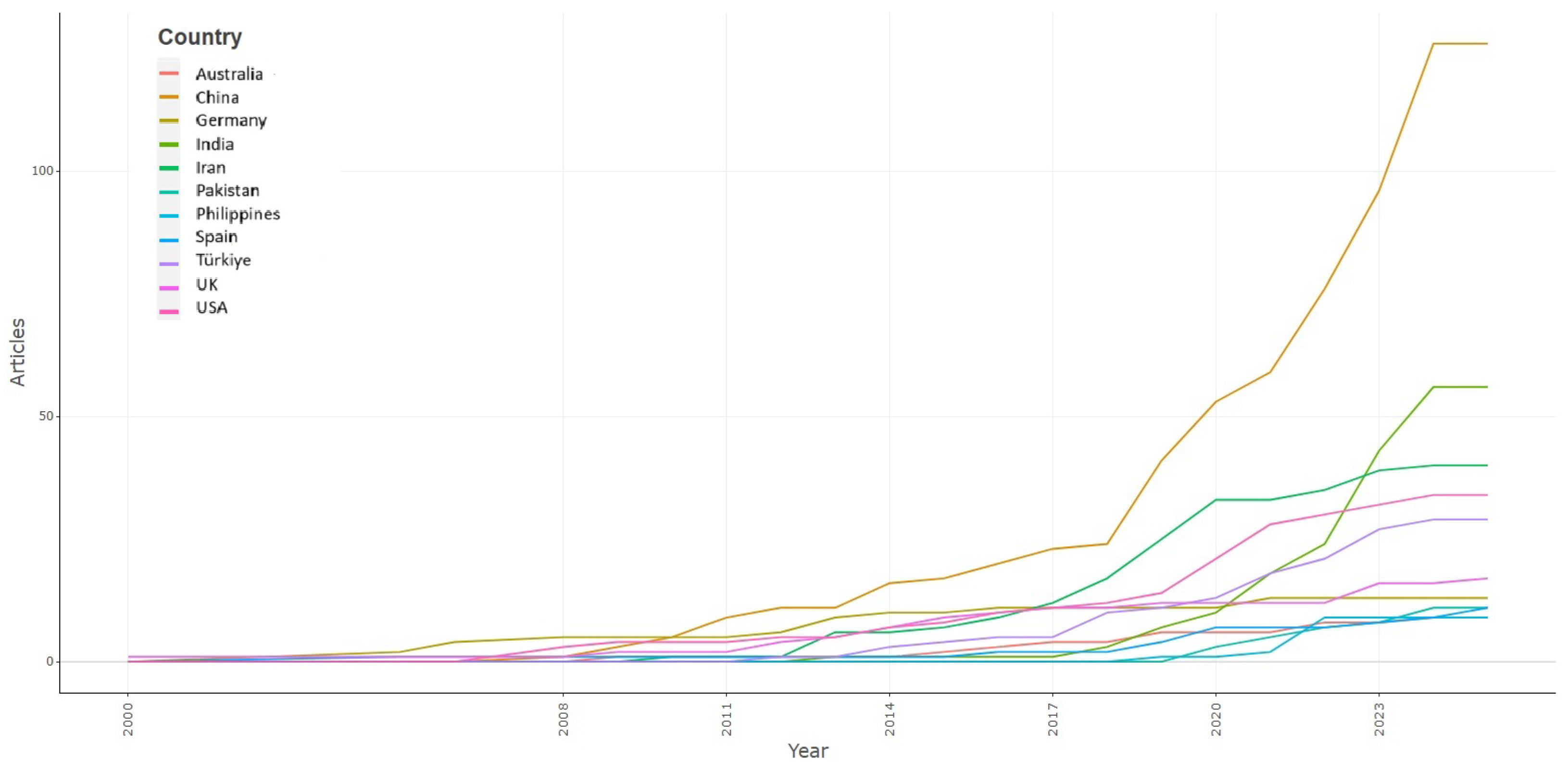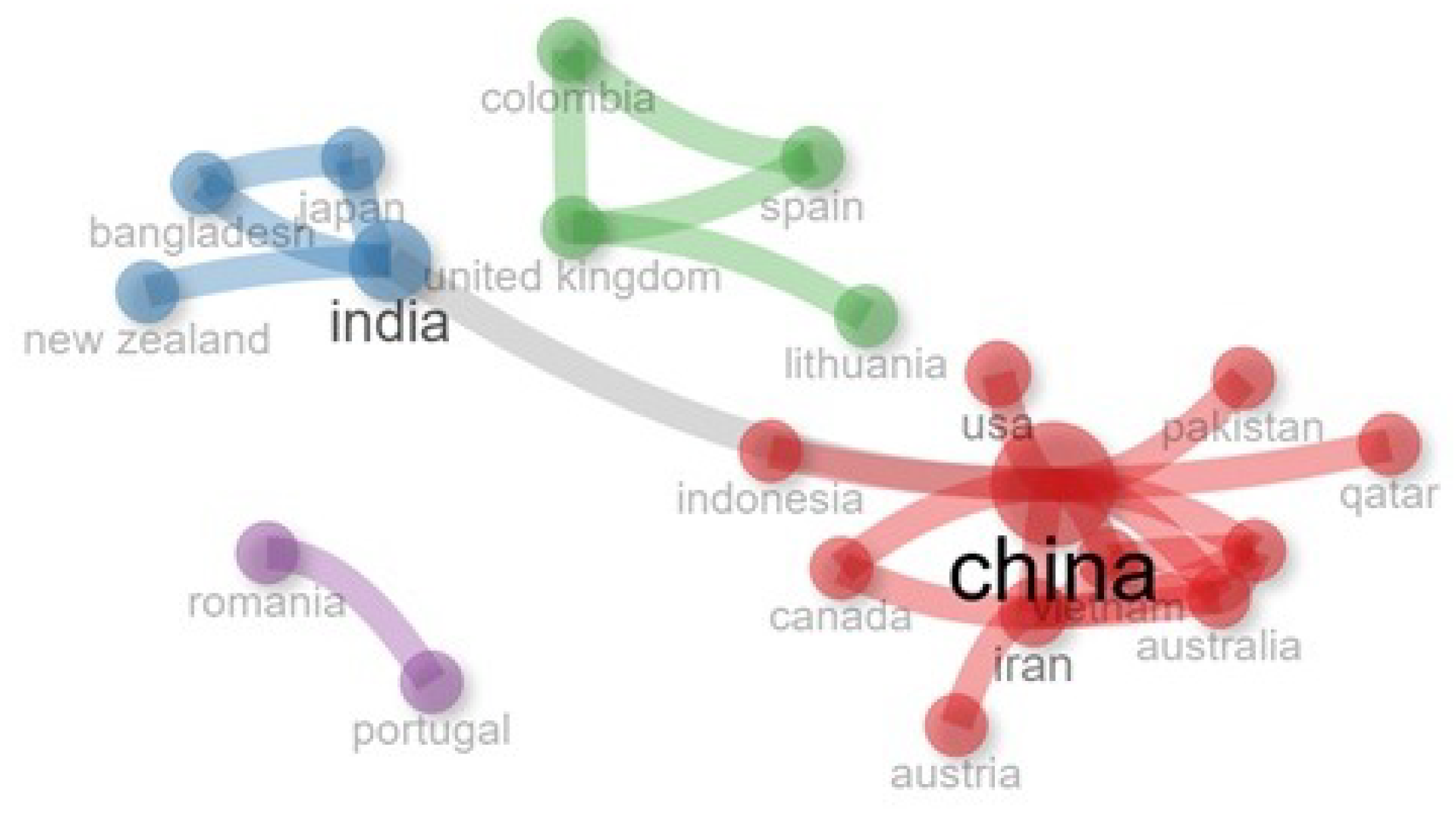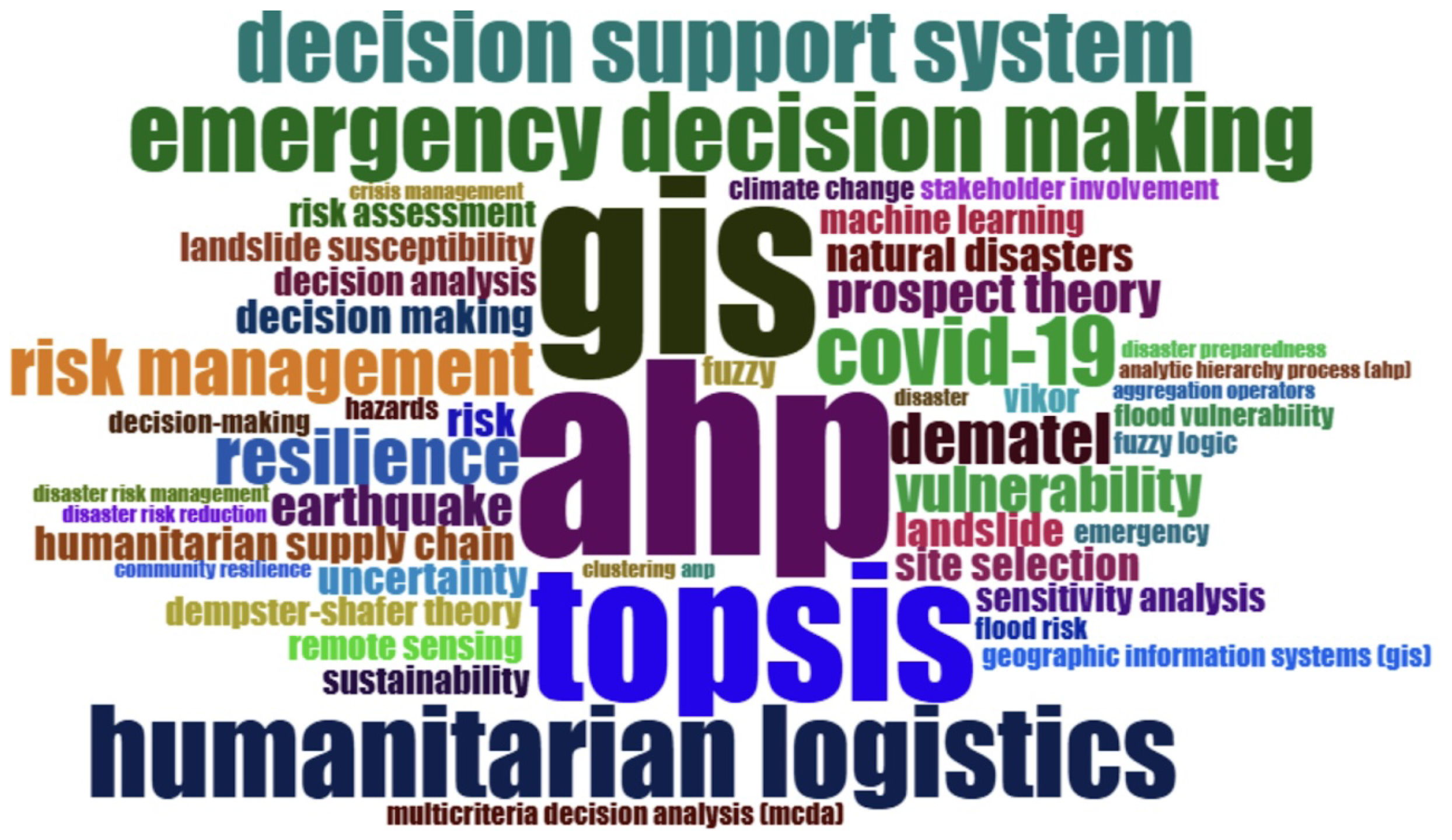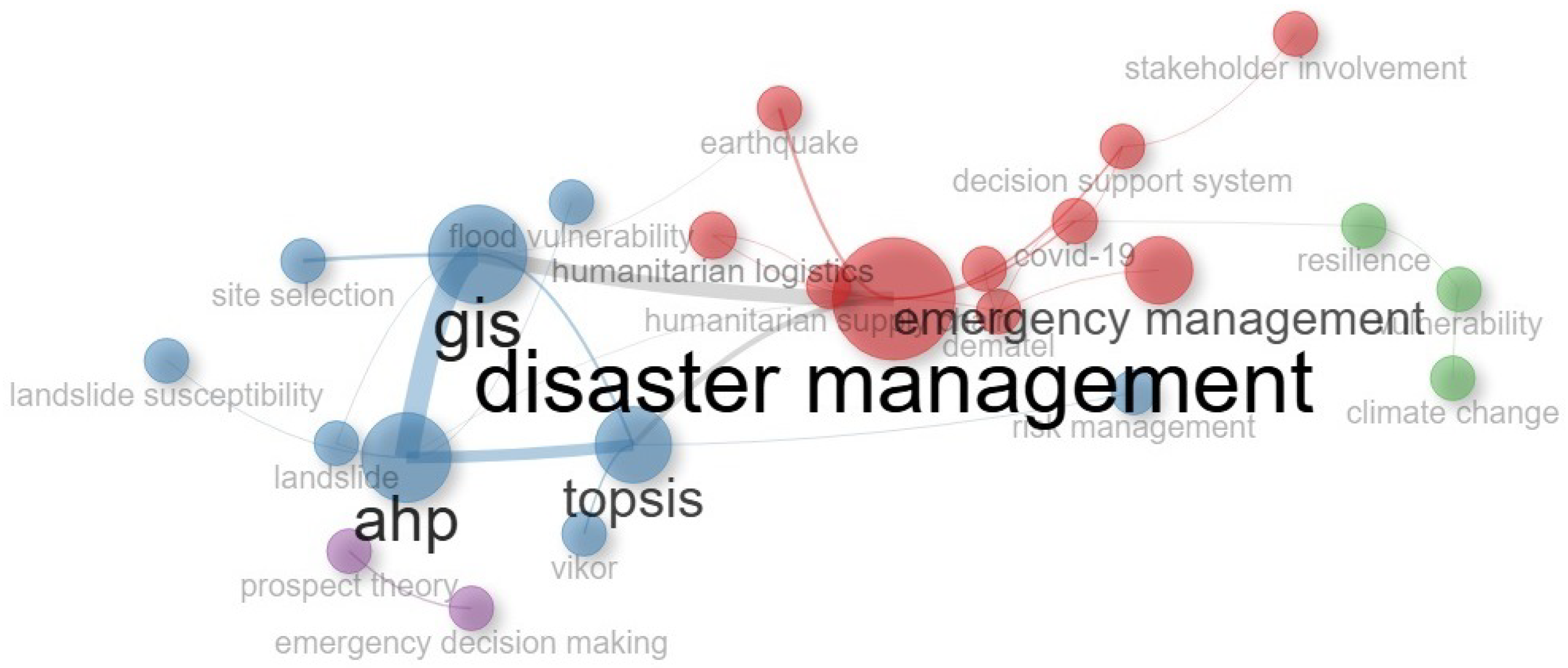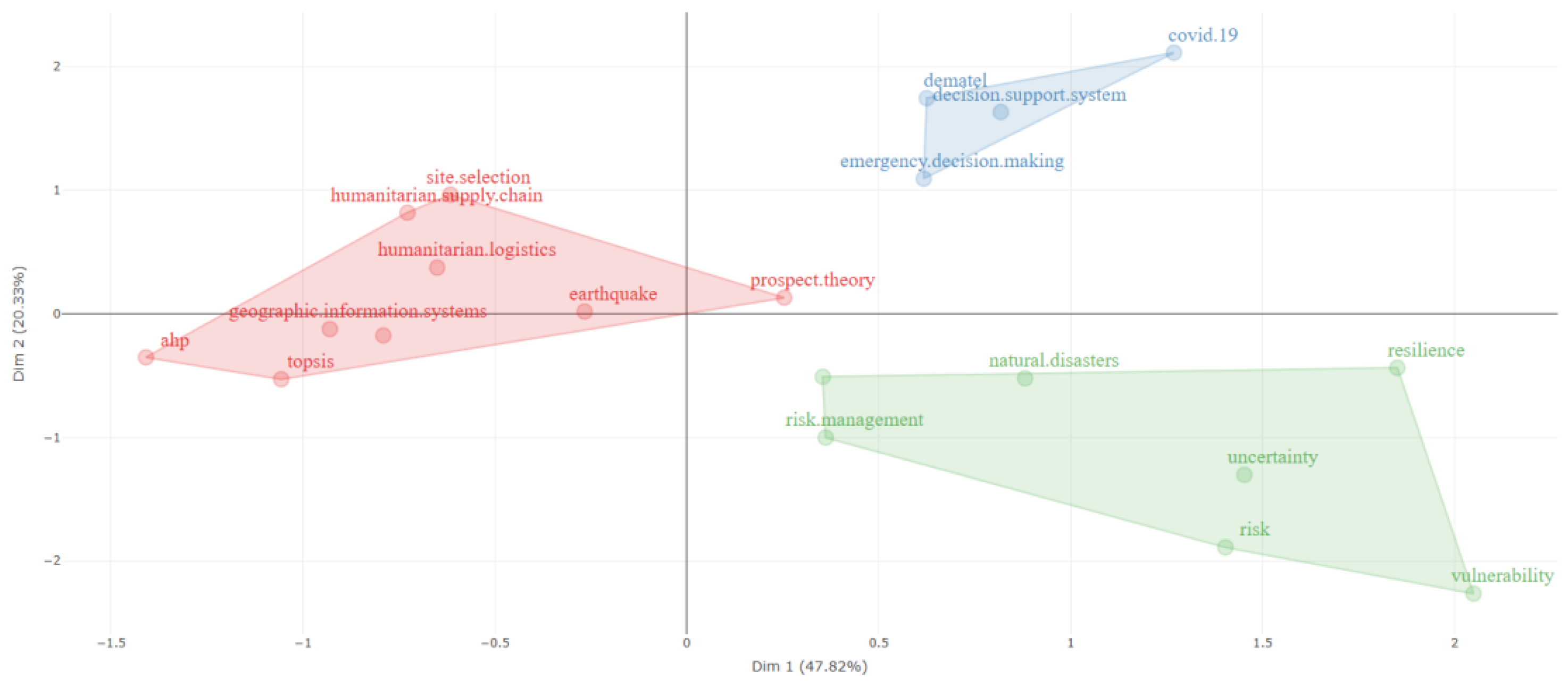1. Introduction
A large number of disasters strike the globe every year, taking thousands of lives, displacing countless individuals, and causing considerable destruction to property and crucial resources [
1,
2]. For instance, the Haiti earthquake on 12 January 2010, with a magnitude of 7.0 and damage of USD 7.804 billion, led to almost 222,000 fatalities and physical damages [
3]. Similarly, on 6 February 2023, two earthquakes with magnitudes of 7.8 and 7.5 rocked Türkiye, resulting in the highest number of casualties in recent memory and an estimated USD 34.2 billion in property damage [
4]. The 2011 Fukushima nuclear power plant explosion in Japan, the 2017 thallium pollution event in China, the 2019 chemical plant explosion in China, the 2019 breakout of the novel coronavirus, and the 2023 Storm Daniel in Libya are just a few examples of the catastrophes that have continued to happen throughout the world during the past 15 years [
5,
6]. These catastrophic events highlight the urgent need for effective disaster management strategies, pushing experts and policymakers to focus on identifying the most effective techniques for cities to prepare and survive disasters [
7].
However, it may not be feasible to completely prevent damages resulting from disasters, strategies, and tools informed by insights from past disasters enable conscious mitigation efforts and preparedness planning, thus unquestionably contributing to effective disaster management [
8,
9]. The devastating earthquakes in Türkiye and Haiti demonstrate the scale of disaster impacts. Still, it is essential to recognize specific examples of successful disaster management approaches, such as those demonstrated by Japan. [
10]. Following catastrophic events such as the Hanshin Earthquake in 1995, emergency transportation routes were implemented for vehicles carrying emergency supplies and relief materials [
11]. Furthermore, Japan initiated the nationwide Earthquake Early Warning (EEW) service in 2007, aiming to allow citizens sufficient time to take proper safety precautions before an earthquake occurs to mitigate the effects of the disaster [
12,
13]. Japan’s enhanced disaster preparedness played a significant role in effectively managing the process with as little damage as possible during the notable (7.5 magnitude) earthquake that struck the Noto Peninsula on 1 January 2024 [
11]. Similarly, the 7.0 magnitude earthquake that struck California, USA, on 6 December 2024, resulted in minimal damage. As demonstrated by the successful disaster management examples in the previous cases, the effectiveness of rigorous regulations and educational programs highlights the significance of scientific knowledge and approaches in bolstering disaster resilience [
14]. Despite this, successful disaster management is an important global issue.
Making an accurate and prompt choice becomes difficult due to the inevitable complexities, uncertainty, and physical limits associated with such occurrences. Given the inherent complexity and uncertainty in disaster scenarios, decision-making becomes a multifaceted challenge. In this context, MCDM techniques provide a structured approach to navigating these challenges. In recent decades, there has been notable interest in disaster operations management literature regarding Operations Research [
15,
16]. MCDM techniques have emerged as a significant domain within operations research, addressing the complexities of decision-making by evaluating competing criteria. These techniques can be effectively applied to both primary and supplementary activities in disaster management, assisting decision-makers and policymakers make more informed choices [
17,
18].
In many different fields, such as logistics [
19], supplier selection [
20], education [
21], healthcare [
22], waste management [
23], manufacturing [
24], humanitarian supply chain management [
25], and disaster management [
26], MCDM techniques are widely used to solve complex problems. This widespread application has contributed to the notable increase in literature review studies, considered a valuable method for examining and analyzing previous contributions to a field through relevant keywords [
27].
Despite the increasing application of MCDM techniques in academic studies, there is a relatively limited number of comprehensive studies addressing their use in disaster management. Abdullah et al.’s [
28] review of the literature from 2000 to 2020 focused on using MCDM techniques in the mitigation, preparedness, response, and recovery of water-related disasters, such as floods and droughts. Similarly, Ozbey et al. [
29] conducted a comprehensive study to highlight the contributions of MCDM techniques to recent research and investigate the stages at which they are employed in disaster management. Specific investigations incorporate bibliometric analysis with systematic literature reviews. For instance, Hou et al. [
6] broadened their focus to cover subjects like probability theory and Bayesian networks in their review and bibliometric analysis of the literature on emergency decision-making from 2010 to 2020.
Although prior research has provided valuable insights, much of it predates the surge in studies conducted over the past five years. With 63% of existing studies emerging since 2020, there is a clear need for a more updated and comprehensive review to capture recent advancements and trends.
Compared to literature reviews, bibliometric analysis has emerged as a powerful tool for visualizing research within a specific field (such as the distribution of studies, authors, institutions, and keywords). It is a crucial methodology for understanding network analysis, current trends, and main contributions [
30].
Given this field’s significant momentum in the past five years, to the best of our knowledge, no bibliometric study has been conducted with the same scope as this study to evaluate the development and impact of MCDM applications in disaster management.
Unlike previous studies, this research not only uses bibliometric analysis to map the intellectual structure of the field but also analyzes high-impact studies from recent years, offering a more dynamic understanding of emerging trends and research priorities. Doing so expands traditional bibliometric analyses and introduces an innovation-driven approach. This study establishes a novel framework that integrates cluster analysis to identify thematic structures and examines recent influential studies not previously explored through bibliometric methods, providing new insights into the field’s conceptual landscape and research development.
The research aims to provide professionals and policymakers with a structured perspective on the statistical and quantitative aspects of MCDM applications in disaster management and emergency transportation, in addition to offering clear guidelines for follow-up research and promoting continuous innovation.
The following research questions are intended to be addressed by the current study:
What is the current state of research on MCDM techniques in disaster management and transportation during emergencies?
How have publications in this field evolved?
What are the most productive research components (sources, authors, institutions, countries)?
Which are the foremost keywords in this area?
Which conceptual building elements make up the core of this area?
What are the emerging trends and potential future directions for MCDM techniques in disaster management?
In order to shed light on these questions and provide a comprehensive perspective, this study employs a bibliometric analysis to map the use of MCDM techniques in disaster management and transportation under emergency conditions. The next section of the study outlines the research methodology, followed by
Section 3, which presents the results.
Section 4 presents discussion and future research directions by introducing the key research findings and offering valuable insights into the future directions, particularly in advancing the application of MCDM techniques in disaster management. Finally,
Section 5 concludes the analysis by summarizing the main contributions and implications.
2. Research Methodology
Recent global catastrophes have revealed the necessity of comprehensive research in disaster management. In this context, a gap in the literature has been recognized regarding the bibliometric analysis of studies that utilize MCDM techniques, which serve as a crucial tool for managing complexities in this field.
For this purpose, a bibliometric approach is applied, examining emerging advancements, key research themes, and future trends in the current literature on MCDM applications in disaster management while responding to the underlying research questions. The present work relies on prior research in areas such as big data and disaster management [
30], humanitarian supply chains [
31], emergency decision-making [
6], multi-criteria classification, sorting, and clustering [
32]. By assessing the current status of MCDM applications in disaster management and transportation under emergency conditions, this study provides a distinct perspective compared to previous research.
A seven-step workflow diagram, outlined in
Figure 1, has been created based on the approach provided by Zupic and Čater [
33] for conducting scientific mapping studies, serving as a roadmap to enhance clarity and engagement for readers.
Stage 0 (Pre-Research) involves selecting a research topic and identifying gaps to establish the study’s foundation. Building on this, Stage 1 (Research Design) refines the research framework by formulating research questions, developing search strings, and selecting relevant databases.
In Stage 2 (Data Collection) and Stage 3 (Data Integration), the final sample was obtained by applying the inclusion and exclusion criteria, ensuring the selection of relevant studies for bibliometric analysis.
The research articles were retrieved from WoS and Scopus based on the defined inclusion criteria, covering studies published between March 2000 and December 2024. The initial search in these databases was conducted using the following search string on titles, abstracts, and keywords:
(“multi criteria decision making” or “multi criteria decision analysis” or “MCDM” or “MCDA” or “multiple criteria decision making” or “multiple criteria decision analysis” or “multiple attribute decision” or “multi attribute decision” or “multiattribute decision” or “multiple attributes decision” or “multi attributes decision” or “multiattributes decision”) and (“disaster management” or “emergency management” or “emergency decision making” or “emergency decision” or ((“disaster” or “emergency”) and (“transportation” or “logistic”)))
The search returned 287 studies from Web of Science and 447 from Scopus, resulting in 734 merged studies, from which a total of 369 studies were excluded based on the following exclusion criteria to obtain a refined and reliable final sample:
Duplication: Excluded duplicated studies (241 records).
Different Languages: Excluded non-English studies (21 records).
Quality Assessment: Excluded out-of-scope studies through manual filtering, including deep screening of titles, abstracts, and keywords. When necessary, specific sections of full texts, including the introduction, methodology, and conclusion were also reviewed (107 records).
After removing 241 duplicates, 21 non-English publications, and 107 out-of-topic studies, 365 publications were considered relevant and examined with the Bibliometrix tool in RStudio 2024.04.0 using R version 4.3.2.
Within this framework, as outlined in Stage 4 (Data Analysis and Visualization), main information about publications, key research metrics (distribution of the most relevant publications and sources), the most productive authors, countries, institutions, co-authorship network analysis, collaboration network of countries, the most influential publications, the most frequent keywords, keyword co-occurrence network analysis, and conceptual analysis are presented and interpreted under the subheadings in the following section.
In Stage 5 (Interpretation), the clusters derived from the conceptual analysis developed using a Multiple Correspondence Analysis (MCA) framework to analyze relationships among keywords are explored in the
Section 4, where key trends in the field are discussed in depth. Moreover, this section investigates the relationships among the most recent studies, identifying their limitations and emerging research gaps.
The final stage of the roadmap provides guidance for future studies by suggesting potential research directions and methodological refinements, contributing to the development of new investigations and the advancement of the field.
3. Results
This section shows bibliometric analysis results to identify research trends and point out key findings.
3.1. Main Information About Publications
Table 1 presents a general classification of academic studies obtained from the WoS and Scopus databases regarding the applications of MCDM methods in disaster management. Articles constitute 80.82% of the publications; conference papers account for 11.78%; review articles comprise 4.1%; the remaining 3.3% comprise other publications.
3.2. Key Research Metrics
Figure 2 illustrates the distribution of research publications between 2000 and 2025. A notable increase in the number of studies was first observed in 2016. The difference of 13 publications between 2015 and 2016 surpasses the total number of studies conducted during the entire period from 2000 to 2009. Following this initial growth in 2016, the field has gained increasing attention, as evidenced by the steady upward trend in publications since 2019. Notably, studies published since 2020 account for 63% of the total publications, underscoring a significant and growing focus on this critical area of research.
Figure 3 highlights that the journals Natural Hazards and International Journal of Disaster Risk Reduction are tied as the most frequently cited sources, each contributing 15 publications. Natural Hazards focuses on disaster preparedness, resilience frameworks, and regional studies, particularly in areas prone to earthquakes and floods. It emphasizes methodologies like risk assessment, geospatial analysis, and decision-making tools such as fuzzy logic and simulation models. Similarly, the International Journal of Disaster Risk Reduction advances analytical methods, utilizing Multi-Criteria Decision-Making (MCDM) approaches such as Analytical Hierarchy Process (AHP) and VIKOR, with applications in humanitarian logistics, green supply chains, and emergency facility optimization. Sustainability (Switzerland), which includes 11 publications, emphasizes integrating sustainable practices in disaster management, focusing on waste management, debris recycling, and sustainable urban development. Topics related to “green transportation” and “urban planning“ remain at the forefront of the debate, supplying essential knowledge on minimizing the environmental impact of disasters and increasing long-term resilience. Collectively, these journals demonstrate the critical interplay between technological innovation, sustainability, and practical frameworks in enhancing disaster resilience and response strategies.
3.3. Top Contributors and Collaborative Trends
Table 2 illustrates the most productive authors in the field, with the top three contributors accounting for nearly one-third of the total publications by the top 15 authors. This remarkable action shows their essential role and leadership in promoting academic growth. Wang Y emerges as the most frequent author, with 10 publications that reflect notable contributions to the subject. Schultmann F, follows closely with eight publications, underlining a strong scholarly presence. Comes T rounds out the top three, with seven publications emphasizing an important role in defining key research directions and trends. Notable contributors to the topic include Liao H, Delavar M, Bertsch V, Geldermann J, and Liu S, all of whom have five publications. Authors such as Abdullah S, French S, Hosseini S, Liu X, Wijngaards N, and Xu Z, with four publications each, expand the research landscape. Finally, Ahuja H, with three publications, highlights the contributions of emerging voices, bringing fresh perspectives to the domain.
Figure 4 displays a collaborative author network, with nodes representing scholars. The size of each node reflects each scholar’s productivity, as regarded by the number of publications, and the thickness of the connecting lines denotes the strength of co-authorship. This network focuses on scholars with at least three collaborative publications, highlighting the most frequent contributors to the subject. The network identifies Schultmann F and Comes T as central figures with extensive collaborations, particularly within their cluster. Wang Y leads a distinct cluster, which reflects local collaborations with authors such as Zheng J and Zhang K. Some authors, such as Chen A and Chen N, or Yucesan M and Gul M, have strong intra-pair interactions. However, their isolated connections to the broader network might be attributed to regional constraints.
Table 3,
Table 4 and
Table 5 collectively provide insights into the origins and key contributors to MCDM techniques in disaster management research. China leads with 126 publications, followed by India with 56 publications, approximately 20% of which are from the University of Delhi. Iran contributes 40 publications, with more than 50% derived from the University of Tehran. The USA contributes 34 publications. Türkiye ranks fifth with 29 publications, 41% of which are from Istanbul Technical University and Munzur University, emphasizing its rising importance in research. Meanwhile, the UK, Germany, and Pakistan contribute a smaller but steady share of publications. The citation impact study reveals differential patterns of influences. China maintains the lead with 1739 citations. However, China’s influence appears less dominant when average citations per publication are considered, with a value of 20.7, indicating a focus on producing a larger research volume rather than achieving a higher impact per study. In comparison, Türkiye is a high-impact country with 969 citations and an average of 38.8 citations per publication. Similarly, with averages of 42.5 and 74.0 citations per article, Germany and Austria exhibit remarkable effectiveness.
Figure 5, depicting the cumulative productivity graph of countries, illustrates a rapid growth in research production after 2017, with China and India showing significant upward trends. This reflects the expanding globalization of research and the rising contributions from developing countries.
Figure 6 shows the global and regional dynamics of cooperation research endeavors using MCDM techniques in disaster management research, with different colors expressing groups of closely cooperating states. For example, China (in red) operates as the central hub with 10 links, demonstrating its extensive international research relationships, notably with the United States, Iran, and Pakistan, whereas European countries like the UK and Spain (in green) demonstrate focused intra-regional collaboration. Some clusters, such as the blue cluster centered around India, show more regional links between countries like Bangladesh and Japan. Additionally, the purple cluster (e.g., Romania and Portugal) indicates smaller, more isolated collaborations.
Based on the “Total Citations” and “Total Citations per Year (TC/Year)”, the top 10 most relevant studies are summarized in
Table 6. Kavzoglu et al. [
34] applied MCDM and Support Vector Machines (SVM) for landslide susceptibility mapping in Trabzon, Türkiye, showing that these methods outperformed conventional logistic regression models. De Brito and Evers [
35] conducted a comprehensive review of MCDM applications in flood risk management, highlighting the popularity of AHP methods and the need to address uncertainties and stakeholder participation. Gigović et al. [
26] developed flood hazard maps for urban areas using an innovative IR’AHP methodology, demonstrating higher accuracy than traditional AHP methods. Gutjahr and Nolz [
36] explored multi-criteria optimization in humanitarian aid, emphasizing the importance of balancing objectives such as cost, speed, and safety in disaster management. Souissi et al. [
37] utilized AHP in a GIS framework to map flood susceptibility in the Gabes region. They identified elevation as the most critical factor and validated their findings through susceptibility zones histogram. Ahmed [
38] utilized GIS-based MCDM techniques to create landslide susceptibility maps for the Chittagong Metropolitan Area in Bangladesh, validating the results with historical landslide data. Finally, Erener et al. [
39] conducted a comparative analysis of GIS-based MCDM, Logistic Regression (LR), and data mining techniques for landslide susceptibility mapping in Türkiye’s Artvin province. The study revealed that LR and data mining techniques demonstrated superior performance compared to GIS-based MCDA and suggested that combining these methods could further improve overall effectiveness. Additionally, the works of Sheu [
40], Yu and Lai [
41], and Li et al. [
42] are discussed in
Section 4 to highlight their methodologies and implications.
3.4. Wordcloud of the Most Frequent Keywords
Figure 7 and
Table 7 present an overview of MCDM techniques for disaster management research’s most frequently used terms, highlighting the field’s methodological and thematic priorities. The word cloud in
Figure 7 emphasizes key concepts such as “AHP”, “TOPSIS”, “GIS”, and “Humanitarian Logistics” which dominate the debate, reflecting the central role of Multi-Criteria Decision-Making (MCDM) tools and geospatial technologies.
Table 7 highlights that “AHP” and “TOPSIS” are among the most commonly utilized words, showcasing their widespread adoption in ensuring the effective use of limited resources and enhancing decision-making processes. Also, “GIS” underlines the critical position of geospatial data in risk assessment and strategic planning. While emerging terms like “COVID-19” indicate responsiveness to current global challenges, concepts like “humanitarian logistics”, “risk management”, and “resilience” highlight the operational focus.
Figure 8 showcases the co-occurrence network of the Author’s keywords in disaster management research. At the core of the network, “disaster management” acts as the central hub, reflecting its foundational role and strong connections to terms like “emergency management”, “humanitarian logistics”, and “decision support systems”. The blue cluster, centered by “TOPSIS” and “AHP”, demonstrates the crucial role of MCDM methods, which are frequently combined with “GIS” to incorporate spatial analysis into planning and disaster response. On the other hand, the green cluster engages in “resilience”, “climate change”, and “vulnerability” addressing the intersection of long-term environmental challenges.
3.5. Conceptual Analysis
A dimension reduction method, Multiple Correspondence Analysis (MCA), analyzed the author’s keywords to provide insights into the research’s sub-areas. The study revealed three distinct clusters, shown in
Figure 9. The red cluster, defined by keywords such as “AHP”, “TOPSIS”, “site selection”, “GIS”, and “humanitarian logistics” represents research focused on resource allocation, site selection, pre-disaster decision-making, and disaster response strategies. The green cluster encompasses studies aimed at understanding and reducing the impacts of natural disasters. Key terms like “resilience”, “vulnerability”, “uncertainty”, and “risk management” emphasize efforts to enhance disaster preparedness by addressing vulnerabilities and uncertainties. The blue cluster highlights terms such as “COVID-19”, “decision support systems”, “emergency decision-making”, and “DEMATEL” which centers on collaborative frameworks and decision-making processes, particularly in the context of crisis scenarios like pandemics. This analysis offers a clear perspective on disaster management research’s thematic subdivisions, showcasing established areas and emerging priorities.
4. Discussion and Future Research Directions
The conceptual analysis, based on the MCA framework, identified three distinct clusters that represent the key trends within the field, collectively explaining 68.15% of the total variance (Dim 1: 47.82%, Dim 2: 20.33%). This variance explanation indicates a robust clustering structure, validating the thematic organization of the conceptual framework. The most influential publications shaping each cluster and the MCDM methods applied in these studies were analyzed in detail under the following subheadings:
Section 4.1,
Section 4.2 and
Section 4.3.
Cluster 1 integrates MCDM methods (e.g., AHP, Fuzzy AHP, TOPSIS, ELECTRE, SAW, and BMW) and GIS in disaster planning, humanitarian logistics, and resource optimization. This cluster includes keywords such as AHP, TOPSIS, GIS, and humanitarian logistics. Its focus is improving decision-making efficiency in logistic operations and resource allocation during disasters, offering practical solutions to humanitarian challenges.
Cluster 2 addresses the applications of MCDM methods (e.g., OWA, AHP, ANP, and fuzzy logic-based methodologies) in risk and resilience. Keywords associated with this cluster include resilience, vulnerability, uncertainty, and risk management. The studies in this cluster emphasize the importance of managing uncertainty in complex decision-making scenarios and propose robust frameworks for assessing and mitigating risks.
Cluster 3 emphasizes implementing MCDM methods (e.g., TODIM, DEMATEL, and hesitant triangular fuzzy sets-based methodologies) in crisis contexts. This cluster addresses challenges related to group decision-making, stakeholder collaboration, and psychological factors during emergencies. It explores innovative approaches for facilitating collaboration and ensuring effective decision-making under high-pressure conditions.
Section 4.4 focuses on studies published since 2021, which comprise more than 50% of the 365 studies identified as relevant to this research. Among these, a selection of representative studies was examined in detail. These studies explore methods that go beyond the boundaries of the defined clusters and reveal interactions between them. The research gaps identified within these studies were analyzed.
Section 4.5 provides recommendations for bridging these gaps effectively.
Table 8 highlights key publications that align with the conceptual framework of each cluster, balancing thematic relevance and citation volume.
This section provides a detailed discussion of the most influential studies shaping clusters, examines recent trends from the last four years, and outlines potential directions for future research.
4.1. Cluster 1 Disaster Planning and Logistics
This section underscores the critical role of MCDM methods and GIS integration in disaster planning, humanitarian logistics, and resource optimization.
Sheu [
40] proposes a dynamic relief-demand management approach for large-scale disaster logistics, contributing to humanitarian logistics during emergency conditions. The model employs fuzzy clustering to group damaged locations and uses the TOPSIS method to prioritize relief-demand urgency, enabling efficient and adaptive allocation and distribution of resources under imperfect information conditions.
Omidvar et al. [
43] present a systematic model for planning and selecting temporary shelter sites in earthquake-prone Tehran using TOPSIS, ELECTRE, SAW, and AHP, and integrating GIS data. Among these methods, TOPSIS showcases its effectiveness in disaster preparedness and planning, with the lowest Residual Sum of Squares (RSS) error. In contrast, Nyimbili et al. [
44] integrate GIS with AHP and TOPSIS to create earthquake hazard maps. While Omidvar et al. [
43] focus on pre-disaster planning, Nyimbili et al. [
44] apply these methods for hazard identification, showcasing their complementary roles in effective disaster management and mitigation strategies. Nyimbili et al. [
45] build upon their previous work, enhancing it by employing the Fuzzy Analytical Hierarchical Process (FAHP) to determine optimal fire station locations. Expanding on their 2018 study, which utilized GIS with AHP and TOPSIS for earthquake hazard mapping, this approach addresses uncertainties in expert evaluations, offering a more refined framework for urban disaster preparedness. The validation of FAHP through the Best-Worst Method (BWM) further emphasizes its applicability and reliability in complex decision-making scenarios.
Building on these advancements, Yılmaz and Kabak [
46] utilize interval type-2 fuzzy AHP to determine the weights of criteria and TOPSIS to prioritize candidate humanitarian aid distribution center locations for disaster response. Their approach addresses uncertainties in expert judgments, offering a systematic framework for selecting optimal sites for both central and local distribution centers. Together, these works demonstrate the key position of MCDM methods and GIS in disaster planning and logistics. They exhibit how such approaches can optimize resource allocation, enhance preparedness, and improve decision-making processes, establishing a robust pre-disaster and post-disaster management framework.
4.2. Cluster 2 Risk and Resilience
This section underscores the evolution of MCDM methods in addressing risk and resilience challenges, showcasing advancements in seismic risk management, and the integration of fuzzy logic, geospatial tools, and Artificial Intelligence (AI) techniques for emerging applications.
Tesfamariam et al. [
47] build on Yager’s [
57] framework by proposing a fuzzy MCDM methodology for seismic risk management, integrating Ordered Weighted Averaging (OWA) and Dempster-Shafer Theory (DST) to address uncertainty in expert evaluations. Their structured approach to evaluating strengthening alternatives provides a foundation for resilience-focused methodologies in seismic-prone regions. Similarly, Yariyan et al. [
50] expand on Tesfamariam et al.’s [
47] approach by employing OWA alongside fuzzy logic, AHP, ANP, and LR to identify seismic vulnerability zones. Their findings highlight the OWA-LR hybrid model as the most accurate approach for earthquake vulnerability mapping. Whereas Tesfamariam et al. [
47] and Yariyan et al. [
50] focus on seismic resilience, Bostick et al. [
48] extend MCDM applications combined with scenario analysis to encompass broader coastal disaster resilience, emphasizing collaborative decision-making for long-term resilience objectives.
Expanding on the theme of resilience, Moore et al. [
51] design a circular resource model that integrates MCDM to identify strategic locations for repurposing second-use Lithium-Ion Batteries (LIBs), enhancing disaster resilience and sustainability. Hong et al. [
49] complements these efforts by comparing spatial MCDM, bivariate statistical methods, and machine learning techniques to evaluate landslide susceptibility. They identify spatial MCDM as the most accurate and reliable approach for landslide risk assessment. Further advancing risk modeling, Pham et al. [
52] incorporate hybrid machine learning models with MCDM methods to develop a flood risk assessment map. By combining AHP for weighting flood consequences with AI-driven flood susceptibility mapping, the study demonstrates that the AI-integrated MCDM methods offer a reliable solution. Viewed comprehensively, these studies illustrate the adaptability and ongoing innovation of MCDM methods in strengthening disaster resilience, offering customized solutions for diverse hazards and sustainability challenges.
4.3. Cluster 3 Crisis Response and Decision Support
This section highlights how MCDM methods are adapted to navigate the complexities of emergency decision-making, addressing uncertainty, stakeholder collaboration, and psychological factors.
Geldermann et al. [
53] propose an MCDM-based framework utilizing the Multi-Attribute Value Theory to determine the most suitable nuclear remediation action among multiple strategies, emphasizing stakeholder engagement in emergency management. Building on uncertainty modeling, Li et al. [
42] integrate Dempster-Shafer Theory into an evidential DEMATEL approach to prioritize critical success factors in emergency management. Similarly, Fei et al. [
55] adopt a heterogeneous MCDM framework based on Dempster-Shafer Theory to facilitate medical supplier selection during COVID-19, showcasing the adaptability of this theory to diverse decision-making challenges.
Yu and Lai [
41] introduce a distance-based group decision-making methodology to consolidate individual preferences into a group consensus, enhancing decision accuracy and transparency in complex emergency scenarios. This approach underscores the importance of integrating individual evaluations into collaborative frameworks for crisis response.
Focusing on the psychological dimensions of decision-making, Ding et al. [
54] extend the TODIM method with hesitant triangular fuzzy sets, improving group decision-making in emergencies by addressing psychological factors. Liu et al. [
56] further advance TODIM by integrating Type-2 fuzzy sets, offering a new framework for addressing uncertainties and cognitive aspects in crisis decision-making. Together, these studies illustrate the adaptability and evolution of MCDM methods, emphasizing their capability to address the multifaceted challenges of crisis response.
4.4. Most Recent Studies
Recent works published within the last four years demonstrate an increasing convergence across the three clusters to develop more integrated and adaptive disaster management frameworks. These studies demonstrate a shift toward innovative, interdisciplinary approaches, mainly through cross-cluster applications of MCDM methods. This section highlights some of the most influential contributions from 2021 to the end of 2024, carefully selected and organized by year to reflect their impact and relevance within their respective timeframes. These works exemplify research that bridges cluster boundaries and advances the field with novel approaches.
Spanidis et al. [
58] developed a Fuzzy-AHP methodology to plan risk management in surface mining projects by combining probabilistic and cost analysis for hazard mitigation. Building on the adaptability of MCDM methods, Ekmekcioglu et al. [
59] expanded their application to flood-related risks, employing a hybrid fuzzy AHP-TOPSIS approach to generate district-level flood risk maps in Istanbul, incorporating stakeholder perspectives to prioritize vulnerable regions. Similarly, Jiang et al. [
60] advanced the capabilities of TOPSIS by enhancing it with Pythagorean fuzzy sets and Chebyshev distance measures, aiming to improve emergency decision-making in environmental disasters. Further extending the scope of disaster management, Yu et al. [
61] introduced a differential evolution algorithm to optimize Unmanned Aerial Vehicle (UAV) path planning in disaster scenarios, validating the results using AHP and TOPSIS within an MCDM framework. Despite the advancements presented in these studies, a critical gap lies in their limited real-world validation and adaptability to dynamic conditions. These studies are less appropriate for real-time situations with shifting stakeholder needs and environmental variables since many of them are developed and evaluated in controlled settings or mostly rely on previously collected data. These advancements showcase the flexibility of MCDM frameworks to address complex decision-making in both resource optimization and risk prioritization, highlighting their cross-cluster applications in disaster management. Following the foundational contributions of 2021, the subsequent years witnessed significant advancements, particularly in integrating AI into flood risk and post-disaster recovery frameworks.
Incorporating machine learning with MCDM frameworks, Akbarian et al. [
62] developed a flood risk management framework incorporating TOPSIS and machine learning for scenario prioritization across social, environmental, and economic dimensions. Addressing post-disaster recovery, Mohammadnazari et al. [
63] proposed a multi-method MCDM framework for prioritizing post-disaster reconstruction projects, combining TOPSIS, ELECTRE III, VIKOR, and PROMETHEE, and validated results through an Artificial Neural Network (ANN) algorithm. Zheng et al. [
64] advanced emergency decision-making with a heterogeneous multi-attribute retrieval method based on bidirectional projection and TODIM for a rapid alternative generation. Although methodologically advanced, these studies highlight a key gap in practical applicability. Challenges such as computational intensity, reliance on high-quality input data, and resource-heavy implementations limit their use, particularly in resource-constrained and less-developed regions, underscoring the need for more accessible and adaptable solution.
In the context of landslide susceptibility mapping, Khalil et al. [
65] compared machine learning models and MCDM methods, specifically AHP and TOPSIS, to map landslide susceptibility, finding AHP slightly more accurate. Focusing on healthcare decision support during crises, Batool et al. [
66] proposed a decision-making model based on the EDAS method under Pythagorean probabilistic hesitant fuzzy aggregation, enhancing emergency decision-making in medical systems. In a related area, Selerio Jr. et al. [
67] explored social media’s role in COVID-19 preparedness using fuzzy DEMATEL and ANP to prioritize public health strategies. Liu et al. [
68] presented an ELECTRE II-based MCDM framework utilizing double hierarchy hesitant fuzzy sets for emergency logistics provider decisions. Although these frameworks are effective for specific areas, their scalability and adaptability to broader disaster management scenarios is yet to be determined.
In recent years, flood risk assessments have continued to dominate the literature. Taherizadeh et al. [
69] mapped flash flood risk areas by combining DEMATEL, GIS, and ANP methods, emphasizing topographical impacts in Iran. Extending the focus to sustainable flood management, Zabihi et al. [
70] designed an AI-supported decision support system for sustainable flood management, combining predictive modeling with TOPSIS, AHP, and OWA methods to prioritize strategies across pre-flood, during-flood, and post-flood phases. Advancing predictive flood modeling, Wu et al. [
71] utilized Fuzzy AHP with the CA-Markov model to evaluate and project flood risks, addressing uncertainties and improving predictive accuracy. AbdelAziz et al. [
72] applied the Neutrosophic Ordinal Priority Approach (N-OPA) within a GIS-IoT framework to optimize disaster preparedness and drone deployment in flood-prone areas of Egypt. Shifting the focus to seismic risk assessment, Rai et al. [
73] assessed seismic risk on India’s eastern coast by merging AHP, CRITIC, and ANN methods to map earthquake vulnerabilities. Finally, Huang et al. [
74] introduced a seismic risk assessment tool merging SELENA and a customized MCDM methodology to evaluate and prioritize mitigation actions. The increasing focus on flood and seismic risk assessments highlights the growing need for predictive models and MCDM frameworks that address uncertainties across diverse hazard scenarios. However, these studies reveal a notable gap in integrating multi-hazard scenarios, such as flood-induced landslides or earthquake-triggered tsunamis.
Recent studies have incorporated real-world applications, such as stakeholder-driven flood risk mapping in Istanbul [
59], post-disaster project prioritization using actual reconstruction data [
63], landslide susceptibility mapping in Muzaffarabad based on actual environmental factors [
65], and emergency rescue facility location selection within the Sichuan-Tibet multimodal transport network [
75]. However, these efforts primarily focus on regional or localized applications, often relying on historical data rather than real-time, dynamic conditions, and demonstrate the feasibility and adaptability of MCDM methods for specific disaster management challenges. Therefore, broader studies remain needed.
This section reviews some of the most recent and influential studies, highlighting efforts that extend beyond traditional boundaries and build bridges across clusters in disaster management research. These works showcase innovative applications of MCDM methods while revealing several limitations, such as scalability, multi-hazard integration, computational intensity, stakeholder engagement, and large-scale real-world validation. The limitations identified here offer valuable insights into future research priorities, including the development of real-time decision-making frameworks and the incorporation of AI-driven solutions. Addressing these challenges not only underscores areas open to development but also lays the groundwork for innovative research paths, which will be detailed in the next section.
4.5. Future Directions
Recent studies, as shown in the previous section, have expanded the boundaries of disaster management research, yet they also reveal significant gaps such as scalability, multi-hazard integration, and real-world validation. Tackling these gaps requires innovative solutions incorporating emerging technologies and promoting adaptability, resilience, and inclusivity. This section explores key research avenues to bridge these gaps further and advance the field.
Studies by Jiang et al. [
60], Yu et al. [
61], and Huang et al. [
74] underscore the critical role of real-time tools in disaster management. Merging IoT technologies and GIS systems enables the incorporation of live data streams, making these systems more adaptable to changing conditions. AbdelAziz et al. [
72] further demonstrate the potential of IoT and GIS in drone-based disaster management, particularly for real-time monitoring of critical infrastructure and resources. Future studies could explore combining MCDM frameworks with satellite imagery, IoT systems, and remote sensing to develop real-world solutions for disaster management. These approaches have the potential to offer cost-effective alternatives, making them more feasible for implementation in resource-constrained regions.
However, they still need testing across regional and global contexts, emphasizing the need for universal protocols. This need becomes more pressing due to the lack of standardized validation methods and consistent parameter weighting, highlighting the importance of prioritizing standardized methodologies in future studies to address regional differences effectively.
Scalability is essential for overcoming these challenges and ensuring the long-term effectiveness of these frameworks. Therefore, future frameworks should be adaptable to both low-resource settings with limited data and high-resource environments managing large data volumes, thereby maintaining their relevance across diverse contexts. Advancements in machine learning and AI could address computational complexity in MCDM frameworks through optimized algorithms and streamlined data processing, facilitating their integration into large-scale disaster management systems.
Furthermore, broader and integrated strategies are important to address interconnected risks. For example, Huang et al. [
74] emphasize the value of multi-hazard frameworks that incorporate risks like landslides and earthquakes into unified MCDM systems. Transforming single-hazard models into multi-hazard solutions could enhance their versatility, enabling more substantial long-term planning and improved resilience across various disaster scenarios. Zabihi et al. [
70] and Taherizadeh et al. [
69] highlight the growing impact of climate change on disasters like floods and flash floods. Future research could focus on prediction models and satellite data to incorporate climate adaptation strategies into MCDM frameworks to address multi-hazard scenarios, such as floods triggering landslides.
Ultimately, addressing these challenges also requires a deeper understanding of stakeholder perspectives, as Ekmekcioglu et al. [
59] indicated. While stakeholder engagement remains a key challenge in real-time applications due to dynamic needs and limited resources, it also offers an opportunity to enhance disaster management frameworks. To improve inclusivity, future research could prioritize stakeholder-driven MCDM models to promote inclusive and collaborative planning, particularly in vulnerable and resource-constrained regions. Stakeholder perspectives could further enhance the development of sustainable and eco-friendly post-disaster transportation systems by integrating MCDM models to improve collaboration, resource allocation, and route optimization. By addressing these research priorities, future studies could drive transformative advancements in disaster management, paving the way for a more resilient and sustainable global future.
5. Conclusions
In the past decade, the world has faced a marked increase in the frequency and intensity of natural disasters, alongside significant challenges such as pandemics and earthquakes. These events have highlighted the essential function of disaster management and the importance of convenient and effective transportation in emergencies.
This study conducts a bibliometric analysis to assist researchers and decision-makers in understanding the potential of MCDM techniques for disaster management and transportation during emergency conditions, focusing on 365 studies published between March 2000 and December 2024.
This analysis provides insights into the trends, the most productive research components (including sources, authors, affiliations, and countries), the foremost keywords, and existing gaps in the literature, offering a comprehensive understanding of the area. The three leading sources in the field are Natural Hazards, International Journal of Disaster Risk Reduction, and Sustainability. In the ranking of the top 10 most productive countries based on the number of publications, China, India, and Iran dominate the top three positions, while in the institutions ranking, the University of Tehran, the University of Delhi, and Nanjing University of Information Science and Technology hold the leading spots. China stands out for its extensive intra-regional collaborations in the collaboration network of countries. At the individual level, however, co-authorship network analysis reveals Schultmann F and Comes T as central figures with significant collaborations, particularly within their cluster.
China’s leadership in publication output is closely linked to its historical disaster experiences. Frequent disasters in the Sichuan-Tibet region have severely impacted the multimodal transport network, prompting the 2018 Three-Year Action Plan to enhance resilience. Beyond improving transport efficiency, this initiative fostered research on disaster preparedness and recovery. For instance, Guo et al. [
75] applied a hybrid approach combining TOPSIS and the NSGA-II-CA genetic algorithm in a real-world study in the Sichuan-Tibet region, optimizing emergency rescue facility locations and demonstrating how strategic deployment can accelerate recovery and reduce economic losses.
In a similar vein, Iran’s substantial contribution to disaster-related research is rooted in its disaster history, such as the 2019 floods. Mohammadnazari et al. [
63] applied an integrated approach combining TOPSIS, ELECTRE III, VIKOR, and PROMETHEE to prioritize post-disaster reconstruction projects through a case study on projects carried out by a private company, shaping future disaster response strategies.
In the keyword frequency analysis, the keywords “AHP”, “TOPSIS”, “GIS”, and “humanitarian logistics” constitute 40% of the total frequency of the top 25 keywords. In the keyword co-occurrence analysis, “disaster management” acts as the central hub, showing strong connections to “emergency management” and “humanitarian logistics”. The cluster centered around “TOPSIS” and “AHP” frequently highlights the integration of these methods with “GIS”, emphasizing their role in spatial analysis.
Based on the interconnections among the authors’ keywords, the body of research in the area was classified into three major clusters. Cluster 1 focuses on Disaster Planning and Logistics; Cluster 2 addresses Risk and Resilience; and Cluster 3 explores Crisis Response and Decision Support. The most influential studies were discussed within each cluster, highlighting their main contributions and advancements.
This analysis also revealed a notable surge in scholarly activity in recent years, with more than 50% of the relevant studies in the field published since 2021. This recent growth signifies a shift beyond the boundaries of the established clusters as studies increasingly foster interactions across clusters and integrate novel methodologies into MCDM frameworks. These developments, extensively discussed in the
Section 4.4, reflect a transition toward more comprehensive and hybrid approaches, paving the way for emerging research directions that address the complex challenges of disaster management and transportation in adaptive and holistic ways.
This study reveals limitations such as adaptability to dynamic conditions, multi-hazard integration, and computational intensity. The
Section 4.5 outlines potential future research directions to address these challenges. These include combining methods with real-time monitoring tools, focusing on prediction models, and utilizing satellite data, all collectively paving the way for transformative advancements in the field. While this study sheds light on future research opportunities regarding the application of MCDM techniques in disaster conditions, it is crucial to acknowledge certain limitations.
The analysis is limited to publications from the Web of Science and Scopus databases, as those indexed in other databases may have been missed. Future research may benefit from carefully integrating additional databases that align with study objectives, which can help expand the scope of their analyses. Moreover, geographic and cultural factors influencing MCDM applications still need to be explored. Additionally, this study focused solely on papers published in English, which may have excluded valuable contributions available in other languages. It is essential to recognize that search queries cannot be entirely perfect, and as a result, this study may include instances of false positives and negatives.
Furthermore, this bibliometric analysis did not include critical MCDM methods such as RANCOM, SESP-SPOTIS, and ESP-COMET, which were not covered in the relevant studies examined. Future studies could incorporate these methods by employing a broader search string for a more comprehensive analysis. For instance, Elkady et al. [
76] applied RANCOM as a weight-setting technique to adjust criteria weights for prioritizing stakeholder interactions in disaster management, aiming to enhance community resilience. Meanwhile, Pham et al. [
77] utilized SPOTIS to assess sustainable development, considering the impact of climate change as an underlying driver of disaster risks. Incorporating these methodologies into disaster management frameworks could provide deeper insights into decision-making processes, further strengthening methodological advancements. Despite these limitations, this study constitutes a substantial step towards achieving its aims and encouraging further research in this area.
